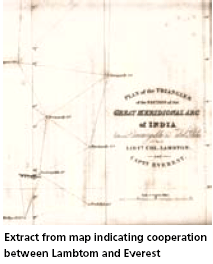| History | |
George Everest: Early years in India
|
|
||||||||||

George Everest entered the Bengal Artillery as a Lieutenant on 4 April 1806 before he had even reached his 16th birthday. This rapid promotion was due to the number of vacancies at that time. Little has come to light about the first few years of his service in India until the siege of Kalinjar near Allahabad in 1812. The first corroborated appearance of Everest involved in survey work is in 1813 when he was in Java although one reference suggests that he may have been there as early as 1807. Java at that time under Dutch control was of prime importance to the East India Company which had various settlements there but the capital, Batavia was overrun by the French in 1811. As a result the Governor General of India sent a force to recapture the city which they achieved on 26 August 1811. It was held until 1816 when it was restored to the Dutch. In the intervening 5 years the East India Company took the opportunity to make detailed surveys of important parts of the island.
A reconnaissance was started in 1812 but in 1815 Lt Everest was appointed to complete the survey. Maybe it was because of his known interests in mathematics and astronomy that Everest was given this task as there is no mention of any survey practice for him before then except that which he would have done whilst at the Woolwich Academy. In fact young Everest was very keen to learn and it is said that one of his first acts after reaching India was to seek out appropriate teachers of the local languages so that he might be achieve reasonable fluency. After this he sought fresh subjects to study and found some mathematical and astronomical textbooks and became self-taught to a very high standard in these subjects. This ability was to be of considerable use throughout his life. For any survey work he did he was obliged to purchase his own equipment so he had but a simple form of theodolite to use. As might be expected, the areas of particular interest were the strategic ones of mountains, harbours, communication routes and near-shore waters. Everest arrived back in Calcutta on 20 November 1916. A few months later his skills were sought in relation to the introduction of a visual telegraphic system stretching west from Calcutta. He had hardly got half way on this scheme that was to cover 400 miles when he heard of his appointment as Chief Assistant to Col. William Lambton on the Great Trigonometrical Survey. On completing the telegraph line he marched from its terminal at Chunar to Hyderabad surveying the route as he went. Everest joined Lambton on 8 January 1819 and the two of them observed some of the Arc stations near Bidar. An indication of Everest’s ability is given by the fact that within three weeks he was in full control of the sections he was observing. Unfortunately his initiation into the GTS was in one of the worst parts of the country as far as health, vegetation, and climate was concerned He had one problem after another and he described many of these eloquently and at some length in various of his Reports. But conditions only worsened and by October 1819 he was seized by fever and in just five days 150 of his followers were similarly struck down. While making their way back to Hyderabad 15 of the followers were to die. Although Everest tried to continue the next year within weeks he was a gain struck down and on 1st October 1820 sailed to the Cape of Good Hope to recuperate. ReferencesSmith, J.R. 1999. Everest. The Man and the Mountain. Whittles, Scotland.
|
||||||||||















 (2 votes, average: 4.50 out of 5)
(2 votes, average: 4.50 out of 5)



